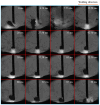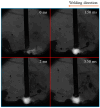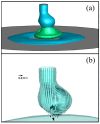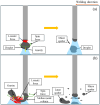Effects of Longitudinal External Magnetic Field on Metal Transfer Behavior and Spatter Formation in CO2 Arc Welding
- PMID: 39942203
- PMCID: PMC11818449
- DOI: 10.3390/ma18030537
Effects of Longitudinal External Magnetic Field on Metal Transfer Behavior and Spatter Formation in CO2 Arc Welding
Abstract
Excessive spatter formation in conventional CO2 arc welding significantly diminishes welding quality and efficiency, posing a critical challenge for industrial applications. To address this issue, this study investigated the mechanisms of metal transfer behavior and spatter formation under the influence of a longitudinal magnetic field (LMF) using a shadow-graph technique with high-speed imaging and back-laser illumination, also coupled with Computational Fluid Dynamics (CFD)-based arc-droplet numerical simulations. The results show that increasing the magnetic flux density (MFD) from 0 to 2 mT shifted the transfer mode from the repelled transfer to the globular transfer, while higher MFDs (3-4 mT) induced rotating repelled transfer. The globular transfer at 2 mT was considered to be primarily produced by the centrifugal effect due to the rotational motion of the molten metal inside the droplet, which was caused by the Lorentz force affected by LMF. The higher droplet temperature in this condition also contributed to forming this transfer mode, preventing the formation of repelled transfer through a decrease in the arc pressure. On the contrary, in the higher MFDs, the droplet temperature decreased to increase the arc pressure, lifting the droplet up. Furthermore, the very strong centrifugal effect rotated the molten metal column around the wire axis to induce the rotating repelled transfer. The spatter formation was found to occur with the two-stage motion of the curved long tail without LMF and at 4 mT, and also with the exploding molten metal column at 4 mT, due to an imbalance of the Lorentz force acting on the molten metal. On the other hand, the neck formation facilitated smooth droplet detachment without forming the curved long tail at 2 mT, reducing spatter significantly. These findings offer valuable insights for optimizing welding quality and efficiency by stabilizing globular transfer under an optimal LMF.
Keywords: CO2 arc welding; longitudinal magnetic field; repelled transfer; spatter formation.
Conflict of interest statement
The authors declare no conflicts of interest.
Figures




















References
-
- Cary H.B. Gas Metal ARC welding. In: O’Brien A., editor. Welding HandBook, Welding Processes, Part 1. 9th ed. Volume 2. American Welding Society; Miami, FL, USA: 2004. pp. 147–205.
-
- Yamazaki K., Suzuki R., Shimizu H., Koshiishi F. Spatter and Fume Reduction in Co2 Gas- Shielded Arc Welding by Regulated Globular Transfer. Weld. World. 2012;56:12–19. doi: 10.1007/BF03321376. - DOI
-
- Nakamura T., Hiraoka K., Zenitani S. Improvement of MIG welding stability in pure Ar shielding gas using small amount of oxygen and coaxial hybrid solid wire. Sci. Technol. Weld. Join. 2008;13:25–32. doi: 10.1179/174329307X249289. - DOI
-
- Luo J., Luo Q., Wang X., Wang X. EMS-CO2 Welding: A New Approach to Improve Droplet Transfer Characteristics and Welding Formation. Mater. Manuf. Process. 2010;25:1233–1241. doi: 10.1080/10426914.2010.481000. - DOI
-
- Tokihiko K., Rinsei I., Koichi Y., Yoshinori H. Development of low spatter CO2 arc welding process with high frequency pulse current. Sci. Technol. Weld. Join. 2009;14:740–746. doi: 10.1179/136217109X449238. - DOI
Grants and funding
LinkOut - more resources
Full Text Sources
Miscellaneous

